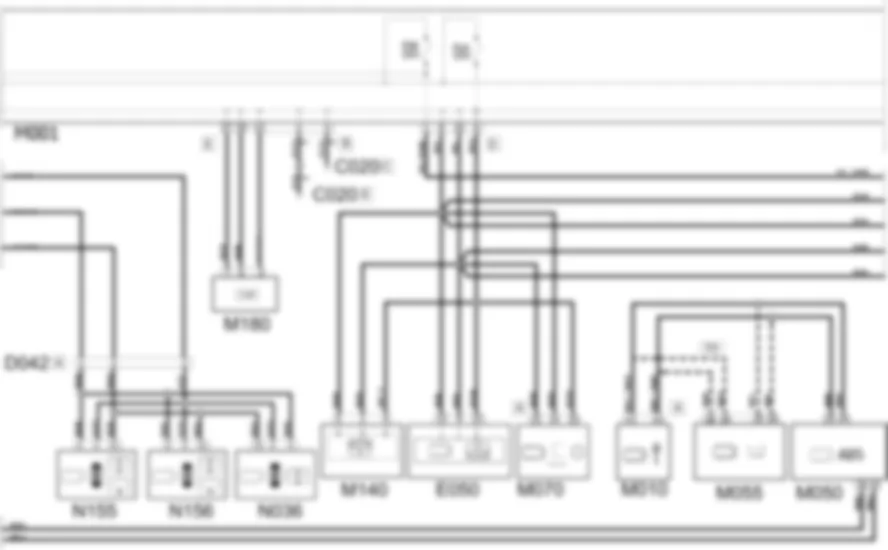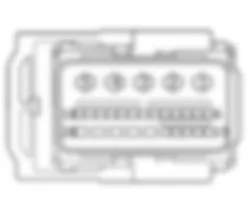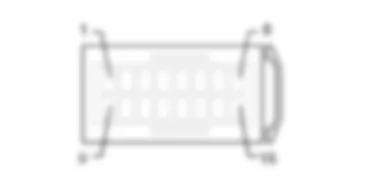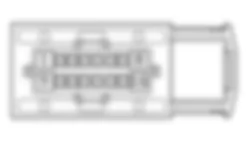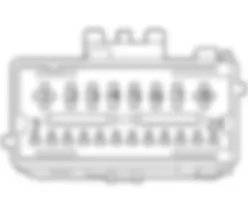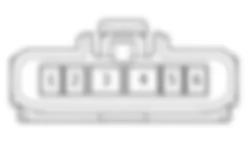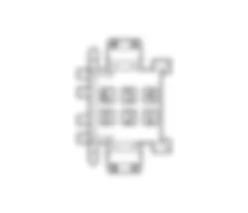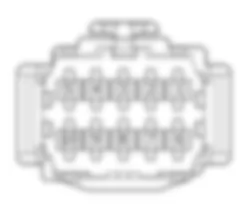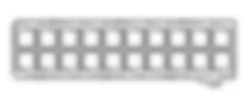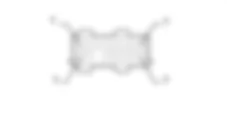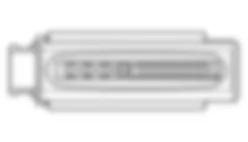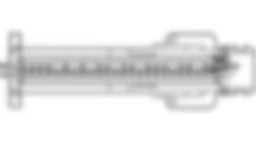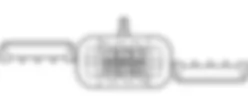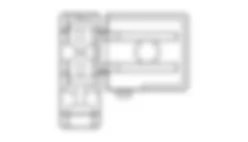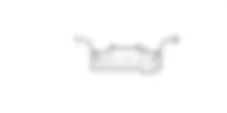
Components - CAN CONNECTION LINES - Fiat ULYSSE 2.2 16V JTD fino a 04/03
| Component code | Description | Reference to the assembly |
| A001 | BATTERY | |
| B001 | ENGINE COMPARTMENT JUNCTION UNIT | |
| C011 | RIGHT FRONT EARTH | - |
| D001 | FRONT/DASHBOARD COUPLING | - |
| D006 | FRONT/REAR COUPLING | - |
| D020 | DASHBOARD/REAR COUPLING | - |
| D030 | DRIVER''S FRONT DOOR COUPLING | - |
| D031 | PASSENGER FRONT DOOR COUPLING | - |
| D042 | COURTESY LIGHT COUPLING | - |
| D070 | DRIVER''S SEAT COUPLING | - |
| E050 | INSTRUMENT PANEL | |
| K125 | RAIN AND DUSK SENSOR | - |
| M001 | BODY COMPUTER | |
| M010 | ENGINE MANAGEMENT CONTROL UNIT | |
| M030 | ALARM CONTROL UNIT | - |
| M047 | TYRE INFLATION PRESSURE CONTROL UNIT | - |
| M050 | ABS CONTROL UNIT | |
| M055 | AUTOMATIC TRANSMISSION CONTROL UNIT | - |
| M060 | AIR BAG CONTROL UNIT | |
| M066 | DRIVER''S DOOR CONTROL UNIT (NPG) | |
| M067 | PASSENGER DOOR CONTROL UNIT (NPP) | - |
| M070 | CLIMATE CONTROL SYSTEM CONTROL UNIT | - |
| M076 | Seats/mirrors with memory control unit | - |
| M084 | PARKING SENSOR CONTROL UNIT | - |
| M093 | STEERING WHEEL NODE CONTROL UNIT (NVO) | |
| M140 | WARNING LIGHTS AND MILOMETER CONTROL UNIT (NSO) | - |
| M160 | CONNECT CONTROL PANEL | - |
| M171 | SLIDING SIDE DOOR NODE | |
| M172 | MULTIFUNCTION SCREEN NODE | - |
| M180 | DIESEL ADDITIVE CONTROL UNIT | |
| M181 | Trailer control unit | - |
| N036 | FRONT SUN ROOF MOTOR | |
| N155 | CENTRE SUN ROOF MOTOR | |
| N156 | REAR SUN ROOF MOTOR | |
| P020 | RADIO | - |
| Component code | Description | Reference to the assembly |
| A001 | BATTERY | |
| B001 | ENGINE COMPARTMENT JUNCTION UNIT | |
| C011 | RIGHT FRONT EARTH | - |
| D001 | FRONT/DASHBOARD COUPLING | - |
| D006 | FRONT/REAR COUPLING | - |
| D020 | DASHBOARD/REAR COUPLING | - |
| D030 | DRIVER''S FRONT DOOR COUPLING | - |
| D031 | PASSENGER FRONT DOOR COUPLING | - |
| D042 | COURTESY LIGHT COUPLING | - |
| D070 | DRIVER''S SEAT COUPLING | - |
| E050 | INSTRUMENT PANEL | |
| K125 | RAIN AND DUSK SENSOR | - |
| M001 | BODY COMPUTER | |
| M010 | ENGINE MANAGEMENT CONTROL UNIT | |
| M030 | ALARM CONTROL UNIT | - |
| M047 | TYRE INFLATION PRESSURE CONTROL UNIT | - |
| M050 | ABS CONTROL UNIT | |
| M055 | AUTOMATIC TRANSMISSION CONTROL UNIT | - |
| M060 | AIR BAG CONTROL UNIT | |
| M066 | DRIVER''S DOOR CONTROL UNIT (NPG) | |
| M067 | PASSENGER DOOR CONTROL UNIT (NPP) | - |
| M070 | CLIMATE CONTROL SYSTEM CONTROL UNIT | - |
| M076 | Seats/mirrors with memory control unit | - |
| M084 | PARKING SENSOR CONTROL UNIT | - |
| M093 | STEERING WHEEL NODE CONTROL UNIT (NVO) | |
| M140 | WARNING LIGHTS AND MILOMETER CONTROL UNIT (NSO) | - |
| M160 | CONNECT CONTROL PANEL | - |
| M171 | SLIDING SIDE DOOR NODE | |
| M172 | MULTIFUNCTION SCREEN NODE | - |
| M180 | DIESEL ADDITIVE CONTROL UNIT | |
| M181 | Trailer control unit | - |
| N036 | FRONT SUN ROOF MOTOR | |
| N155 | CENTRE SUN ROOF MOTOR | |
| N156 | REAR SUN ROOF MOTOR | |
| P020 | RADIO | - |
A CAN (Controller Area Network) structure is used for the electrical connections on the vehicle: it involves a hardware and software solution that is designed to manage the resources on the vehicle efficiently allowing the sharing of information between the various electronic devices, the integration of devices through the use of one network, a high speed exchange of information, a reduction in the amount of wiring/connectors with consequent financial advantages and higher standards in terms of quality and reliability.Since there are a large number of control units on the vehicle, there is also a large amount of information to be managed. The use of the CAN system is therefore advantageous.The signals are transmitted on CAN type serial Bus in which there is one "high" tension cable (H) and one "low" tension cable (L): the bit value transmitted is represented by the difference between the CAN-H and CAN-L voltage levels.The various electronic devices that make up the system, known as network "Nodes", are connected to the CAN by means of communication interfaces known as transceivers incorporated in the actual devices.The exchange of information at CAN type serial lines is only possible using a transmission protocol which is the collection of rules that allow communication between two or more nodes.The main element of the network is the Body Computer Node.The Body computer node is entrusted with the task of activating the network the moment the ignition key is turned to position M.The Body computer node also carries out the task of monitoring the network. In this way it is possible to check the activity status of the network, the functional failure status of the individual electronic devices (nodes) and any possible CAN failure.The structure for this vehicle consists of three communication networks which connect nodes belonging to the different areas (vehicle dynamic control and bodywork functions) and a certain number of complementary serial lines used for diagnosis and other specific functions:- a CAN for dynamic vehicle control (high speed);- a CAN known as the CAN CONF network which connects the Body Computer Node to the information or comfort equipment;- a CAN known as the CAN CAR network which connects the Body Computer Node to the safety or services equipment;The fault diagnosis of the nodes connected to the CAN takes place using the Body Computer Node, whilst the vehicle dynamic control network involves the special K lines.Power is distributed via the junction units and/or fuse boxes in order to ensure maximum electrical protection and minimum wiring complexity.
The body computer node M001 supplies the various electronic control units connected to it via the CAN.At pins 1 and 2 of connector A the Body computer node M001 is connected to pins 4 and 5 (respectively) of connector D of the engine compartment junction unit B001 from which the power supply is received passing through fuses MF04 and MF05 (respectively).The CAN is divided into CAN, CAN CONF, CAN CAR.The CAN CAR network comprises the following components that are connected to the Body Computer Node M001:- at pins 11 connector B, 3 and 5 connector G, the steering wheel node control unit M093 is connected (pins 5, 3, 1 connector A respectively);- at pins 11 connector B, 23 and 21 connector L, the Air Bag control unit M060 is connected (pins 37, 30, 33 respectively);- at pins 37, 38 connector I and 4 connector F, the trailer control unit M181 is connected (pins 1, 2, 4 connector B respectively);- at pins 24, 26 connector L and 3 connector H the rain and dusk sensor K125 is connected (pins 2, 4, 1, respectively);- at pins 4, 1 and 6 connector C, the alarm control unit is connected M030 (pins 10, 7, 12 connector A respectively);- at pins 12 connector B, 35 and 37 connector E, the diesel additive control unit M180 is connected (pins 3, 6, 7 respectively);- at pins 25 and 27 of connector E the engine compartment junction unit B001 is connected (pins 12, 11 connector F respectively).The CAN CONF network comprises the following components that are connected to the Body Computer Node M001:- at pins 38, 40 connector L and 9 connector F, the passenger side door control unit M067 is connected (pins 19, 20, 1 respectively);- at pins 9 connector F, 36 and 38 connector I, the driver''s door control unit M066 is connected (pins 1, 20, 19 respectively);- at pins 3 connector F, 36 and 38 connector I, the seats/mirror with memory control unit M076 is connected (pins A7, A5, C5 connector A respectively);- at pins 36, 38 connector I and 11 connector F the parking sensor control unit M084 is connected (pins 5, 14, 10 connector A respectively), but only one line is protected by fuse F12 (pin 11 connector F);- at pins 36, 38 connector I and 8 connector H the sliding side doors node M171 is connected (pins 5, 4, 12 connector A respectively), but only one line is protected by fuse F08 (pin 8 connector H);- at pins 36, 38 connector I and 3 connector H the front sun roof motor N036, centre motor N155 and rear motor N156 are connected (pins 4, 10, 5 respectively) but only one line is protected by fuse F05 (pin 3 connector H);- at pins 8, 10 and 6 of connector D, the instrument panel E050 (pins 12, 6, 13 respectively), the milometer and warning lights control unit M140 (pins 5, 2, 4 respectively) and the climate control system control unit M070 (pins 15, 14, 10 respectively) are connected, but only one line is protected by fuse F14 (pin 6 connector D);- at pins 8, 10 and 1 of connector D, the multifunction screen node M172 (pins 9, 7, 1 respectively) and the radio P020 (pins 10, 13, 12 connector A respectively) are connected, but only one line is protected by fuse F08 (pin 1 connector D).These last connections may vary depending on the vehicle trim level. At pins 8, 10 and 1 connector D the Connect Nav or Nav+ P020 is connected (pins 10, 13, 12 connector D respectively) and also the following are connected:- at pins 12, 11 and 6 of connector B, the Connect control panel M160 (pins 1, 2, 4 respectively);- at pins 5 and 12 of connector A, the multifunction screen node M172 (pins 6, 4 respectively).Lastly, the CAN (dynamic control network) comprises the following components which are connected at pins 4, 2 of connector E of the Body computer node M001:- the steering wheel node control unit M093 (pins 1, 2 connector D respectively);- the tyre pressure monitoring control unit M047 (pins 9, 18 respectively);- the ABS control unit M050 (pins 15, 26 respectively).If the vehicle is equipped with automatic transmission, the automatic transmission control unit M055 (pins 29, 30 respectively) is connected to the ABS control unit M050 (pins 14, 25) and the engine management control unit M010 (pins A3, A4 connector A respectively) are connected to the former. If the vehicle is equipped with a manual gearbox, the engine management control unit M010 (pins A3, A4 connector A respectively) is connected directly.


